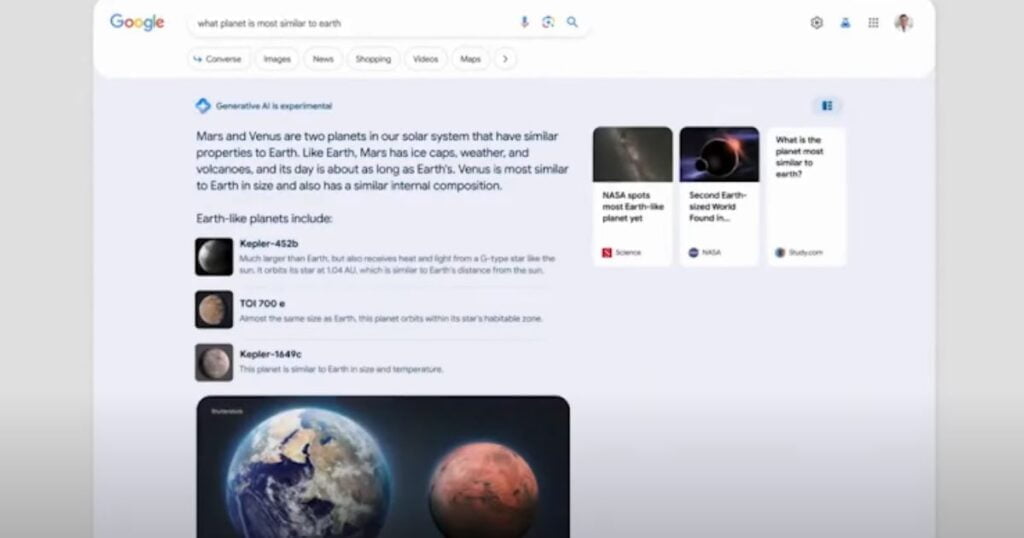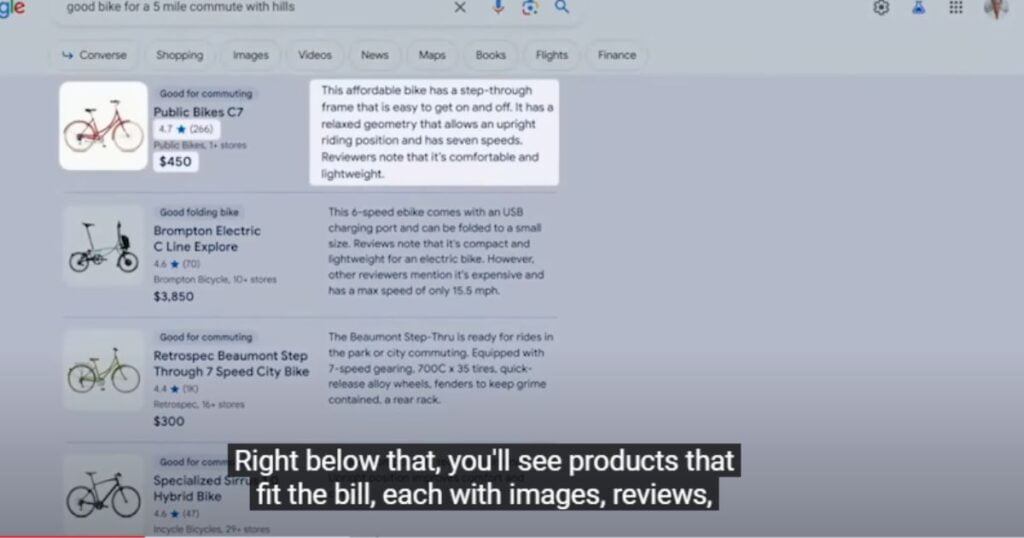SGE: Search Generative Experience

On May 10th, Google announcer plans to completely change search by adding in AI-generated answers.SGE( Search generative experience is described by Google as an AI-powered snapshot. let’s take a look at this. Let’s start with a search for what’s better for a family with kids under three and a dog, Bryce Canyon or Arches. There’s an AI-powered snapshot that quickly gives you the lay of the land on a topic. And so here you can see that while both parks are kid-friendly, only Bryce Canyon has more options for your furry friend. The user is getting their question answered by the AI. There’s no need to look at websites anymore.
The Bad Side of SGE
SGE is an early step in transforming the search experience with Generative AI.
Google
Here’s what it’ll entail. First, we have those AI-powered snapshots, which are gonna appear at the top of the search result fronts and center. This presentation shows how a user searches for planets that are similar to Earth, and they get their answers right here in the top SGE section. This is great for users. They get their answer that Mars and Venus are similar to Earth.

Check this out, for example, let’s say you’re searching for a good bike for a five-mile commute with hills. This can be a big purchase, so if you wanna do your research in the AI-powered snapshot, you’ll see important considerations like motor and battery for taking on those hills and suspension for a comfortable ride. Right below that, you’ll see products that fit the bill, each with images, reviews, helpful descriptions, and current pricing. The user gets an answer, a list of bikes that you won’t make money from because there’s no visit to your website and no clicks on your affiliate links. Sure the AI is most likely to learn how to order these bikes by reading your product review content. But these are all links to e-commerce stores, not you. We also have conversational mode, which would be Google’s answer to ChatGPT the AI will remember what you’re talking about, so you can refine your search with simple follow-up questions like this.

The Good side of SGE
There’s a lot of good to be read between the lines. First of all, I know that some of the AI snapshots don’t look so promising with the three website links on the right and the other links pushed down below. But there are other AI snapshots that show website links front and center like this restaurant recommendation search. Ultimately, though, Google knows they need to keep feeding website traffic for three main reasons. First, if websites stop producing content because they’re not getting any traffic, then what the hell is the AI gonna learn from?
It’d be a pretty impotent AI if it couldn’t properly train itself anymore. Second, because Google ultimately knows that people prefer to read content written by humans, the search will continue to be your jumping-off point to what makes the web so special. Because even in a world where AI can provide insights, we know that people will always value the input of other people, and a thriving web is essential to that. They repeat this message three more times if you dig through their release posts, like when they remind us that with SGE, users will quote quickly, and get the lay of the land on the topic with links to relevant results to explore further. Or that the AI snapshots are a jumping-off point from which people can explore a wide range of content and perspectives on the web, or that people want to hear insights from others to help inform their decisions. So they’ve designed these new experiences to highlight and drive attention to content on the web. People wanna read content, especially purchase decision content written by authors with experience, and Google obviously knows this. Otherwise, why would they release seven product reviews and algorithm updates, and make a complete review of guideline documentation about this very thing?
It doesn’t seem logical to shout from the rooftops that review content should be quoted, written by experts or enthusiasts who know the topic well, only to say, Nah.
What we meant was experts in AI. But the third and most important reason that websites will continue to receive traffic is money. Google makes 58% of its annual revenue. That’s $162 billion from search result ads. This is what Google currently looks like. A big reason that they’re making 162 billion freaking dollars from this is that businesses are paying to put their websites at the top of Google. They’re not gonna pay that much to be placed below the fold under some AI answers. Not only that, but another 11% of their annual revenue, a mere, 32.7 billion, comes from the Google Display Network ads. These are ads that people bid on through Google to be placed on high-traffic websites. If these websites like Forbes, stop receiving traffic, guess what?
People will stop bidding on these ads. Furthermore, there’s gonna be tons of queries for which the AI snapshot just won’t show up. Google said so as well. Quote, there are some topics for which Search generative experience(SGE) is not designed to generate a response. This can be searched with information gaps where SGE doesn’t feel confident in a response. But also queries where Google knows that users want a human touch. Either way, this is gonna be a slow rollout. Google wants to remain the number one search engine and to do that, they’re gonna need to go slow so they don’t lose their user’s confidence. Google is very aware of the limitations of large language models, such as misinterpretations, hallucinations, and bias. However, any way you look at it, websites are gonna lose. Some traffic, there’s gonna be some non-zero amount of traffic lost due to some queries being answered by AI. Maybe that’s just 6%.
Conclusion
In conclusion, the Search generative experience is designed to get a better search experience for users. The Search generative Experience provides a comprehensive overview, with factors to consider and a useful synthesis of relevant insights. As a result, people are able to explore a wide range of content and perspectives on the web starting with these snapshots.





